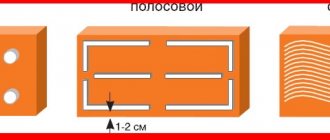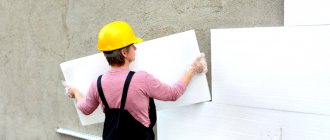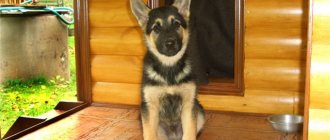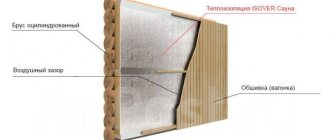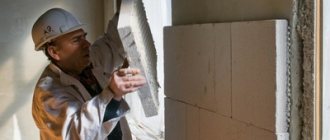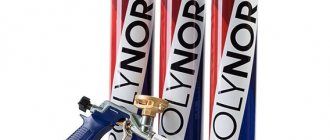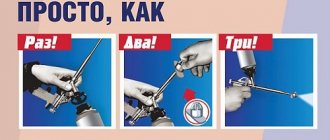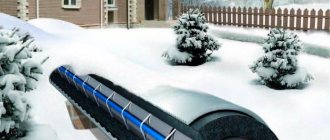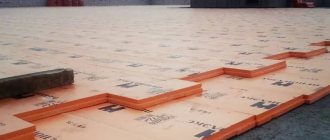A situation often arises when central heating batteries in apartment buildings cannot cope with heating the home and the room becomes cold. There are several ways to cope with this problem, ranging from purchasing additional heating devices to installing autonomous heating.
However, these funds require additional energy costs or significant capital investments when installing individual heating. Few people know that properly insulating an apartment will significantly reduce heat loss and eliminate additional costs for electricity or gas.
Methods for insulating facades
Insulating an apartment or country house from the inside will not provide the required effect, so there will be a risk that the premises will still be cold in winter or that more resources will have to be spent on heating.
Insulating the house from the outside allows you to avoid:
- – formation of condensation resulting from temperature changes;
- – accumulation of humid air indoors, promoting the growth of mold on the walls;
- – the appearance of cracks and destruction of materials filling the joints between the slabs.
Wet facade
There are two common methods of insulation - “wet” and ventilated facades. Both technologies can be used for both brick and panel houses.
The structure of the wet facade includes:
- * thermal insulation layer – mineral wool, polystyrene foam, expanded polystyrene;
- * reinforcement – plaster stack fixed to an adhesive solution;
- * decorative surface finishing - decorative plaster and profile are used.
The advantages of using the “wet facade” technology include quick installation, high level of insulation, and minimal likelihood of efflorescence formation. This type of insulation is suitable for panel, prefabricated, monolithic and brick buildings.
Ventilated facade
A ventilated façade has additional heat capacity characteristics due to the presence of free air space between the wall and the facing material. To insulate walls using this method, non-hygroscopic materials are selected.
Among the advantages of installing a ventilated facade:
- – large palette of colors;
- – free removal of steam, which prevents the accumulation of moist air in the room;
- – maintainability of the system, you can replace a separate part without dismantling the entire lining;
- – long service life.
Disadvantages of insulating a building from the inside
A thick layer of thermal insulation takes up useful space.
Internal insulation of apartments has disadvantages that cannot be ignored:
- Reducing usable space. The material itself has a certain thickness, and it still needs to be covered with plasterboard, which requires additional finishing.
- The need to move furniture. In some cases, when the walls are made to individual sizes, you have to make expensive adjustments or order a new set.
- During the period of work, you need to move out of the apartment so as not to breathe polluted and humid air. Sometimes it may be necessary to remove items that are sensitive to dampness.
- The geometry of the heating system is disrupted. Pipes and radiators do not heat rooms as efficiently, even when the temperature is high.
- Pollution of air and interior items by repair by-products - mortar, glue, dust, small fibers. Carrying out lengthy and labor-intensive general cleaning. There is a high probability of irreversible damage to some objects and surfaces.
The main disadvantage of the internal option is that load-bearing walls are constantly exposed to the environment. Due to temperature changes, concrete panels crack and brickwork loses its solidity. Condensation accumulating under the insulation leads to the formation of mold, which gradually corrodes it and penetrates into the rooms.
How and when is it better to insulate a facade?
For external insulation of the facade, 2-3-layer thermal insulation structures are used. However, the top layer of plaster is not considered one of them. When choosing methods and materials, you must adhere to the following rules:
- – brick, reinforced concrete and block houses can be lined with any type of insulation;
- – frame walls require three-layer insulation, the insulation is located inside, it is surrounded by a ventilated or non-ventilated layer;
- – wooden houses are insulated in 2-3 layers using an air gap, which provides additional ventilation and reduces the risk of condensation;
- – buildings made of cellular concrete require a ventilated and non-ventilated layer; they can be decorated with brick cladding on top.
The building can be insulated when all construction and repair work has been completed, including installation of the roof, installation of window and door openings. The foundation must first be waterproofed and all utilities secured.
It is best to install insulation during the period of the year when the temperature remains positive for a long time (+5 ... + 25 C) and the air remains dry. It is unacceptable to carry out work if the weather forecast includes rain or snow. The optimal time for installing insulation is the beginning of autumn or the end of spring.
Before starting insulation work, the shrinkage of the house must be completed. Otherwise, cracks may appear on the façade in the future.
Entrance door
Not such a problem area as windows or walls, but insulation is also required. The most correct solution is to replace the old door leaf with a jamb with a new, insulated door structure. It is better to contact a specialized organization.
A company employee will come to the site, determine the strength of the partition where the door is planned to be installed, and take the dimensions of the doorway. Then a team of installers will deliver and install a new door.
You need to know all the intricacies of installing a door structure in order to control the work:
- If the wall is thin, then it needs to be insulated. Otherwise, the effect of the new door will be reduced.
- It is necessary to ensure that all joints between the door and the wall are carefully sealed with polyurethane foam.
- It is necessary to check the position of the door in two planes. If the canvas is skewed, then gaps will appear between the canvas and the jamb.
Legal nuances
According to federal laws, unauthorized changes in the appearance of the facade of multi-story buildings are strictly prohibited. To carry out such work, it is necessary to obtain permission from the housing and communal services authorities.
The most difficult thing is to obtain permission to insulate the facades of buildings located in the central part of the city. Here it is better to enlist the support of neighbors to submit a collective application for such work. They approve of her more readily.
It is convenient if the company that will insulate the facade takes care of the issues of obtaining permits.
Important!
By the way, we are engaged in the preparation of construction documentation: obtaining an OATI warrant, a color passport.
The effectiveness of insulation depends not only on the technology used, but also on the correct choice of materials. Let's look at the characteristics of each of them separately.
Insulation of walls using plaster treatment
Thermal insulating plaster is a new fashionable invention in construction for creating thermal insulation of the facade from the outside. It consists of various types of building mixtures in which cement is present mixed with polymer substances and porous mineral-based filler. To work with such plaster, it is necessary to prepare the surface in advance. The process is similar to preparing walls for ordinary plaster mixture. Insulation of houses using heat-insulating plaster is done in the same way as work using conventional plaster.
How to choose material?! Comparison of insulation materials
Basalt wool has the highest performance characteristics. But it is hygroscopic, so without proper waterproofing it will lose its properties over time. This insulation option is suitable for ventilated facades.
Polystyrene foam and extruded polystyrene foam are suitable for insulating the facades of panel houses. These materials are resistant to moisture, so they last 50-100 years. To restore the aesthetics of an insulated facade, it is enough to simply paint it once every 5-10 years.
You cannot use polystyrene foam or extruded polystyrene foam to insulate wooden houses. It is often damaged by rodents and, due to low vapor permeability, causes condensation. If there is excess humidity and lack of ventilation, the wood will quickly rot.
Wall insulation can be carried out at any time of the year. But the weather is important. If it is raining or snowing outside, work should be postponed. Excess humidity is especially dangerous for mineral wool.
Reasons for wall freezing
There are a number of shortcomings or shortcomings in the design of houses that lead to a deterioration in the thermal insulation properties of enclosing structures:
- There must be insulation in the cavity of brick walls. Due to oversight or negligence, it is not installed everywhere. As a result, hollow areas appear in the wall through which heat escapes.
- In panel houses the problem is in the seams. They must be sealed with insulation and then covered with cement-sand mortar. In practice, insulating the seams of apartments often ends with caulking with a solution. Through these cracks, thermal energy escapes out.
- Old wooden window structures or poorly installed plastic double-glazed windows.
- On upper floors, heat can escape through a “cold” attic.
- Old or poorly installed entrance doors.
Only an integrated approach to insulating an apartment will give one hundred percent results. Individual measures will improve the situation, but will not solve the entire problem.
Foam extruded polystyrene foam
Polystyrene foam is the most budget-friendly option. It is produced in slabs with a thickness of 25 mm. The material is resistant to moisture, but at the same time has a low level of vapor permeability.
An improved version of polystyrene foam is extruded polystyrene foam. The material has a flammability grade G1-G2, that is, it does not support combustion. Inside it consists of many small empty cells. This significantly reduces the heat transfer of polystyrene foam and allows it to also be used as sound insulation. The service life of the insulation is from 70 years.
The thermal conductivity coefficient of the material is 0.0228 (W/m/K), with a density of 30 to 45 kg per 1 m3.
Advantages:
- + waterproof, does not get wet and does not lose its performance characteristics when exposed to moisture;
- + ease of installation on the facade;
- + low level of thermal conductivity with minimal thickness;
- + resistance to a wide temperature range, from -100C to +120C;
- + minimal weight, practically no additional load on supporting structures;
- + resistance to inorganic solvents.
Flaws:
- — low level of vapor permeability;
- - quite high cost.
Extruded polystyrene foam is used not only for insulating facades. It is also suitable for attics or basements where there is a high level of humidity.
Advantages of external insulation
Thermal insulation of the end wall with polystyrene foam
Owners of corner apartments know well the consequences of cold winters and extremely hot summers. In extreme cold it is impossible to warm your home, and in sunny weather it is difficult to cool it even with air conditioning.
Coating the end wall with a heat insulator provides the following advantages:
- Useful space is saved. This is relevant for owners of small-sized housing, where every centimeter of space and volume counts.
- There is no need to move furniture or remove anything that could be damaged during repairs.
- External insulation performs not only an insulating function. The material covers all cracks and cracks, protecting rooms from moisture during precipitation.
- All work is carried out outside, the inside is clean and calm. The owners don’t think about where they should temporarily move and how long it will take to restore order.
- The walls are protected from adverse weather conditions and remain stable. All this helps to extend their service life and maintain performance characteristics.
The main thing in this method is that heat loss will be greatly reduced, and dampness will not penetrate inside.
Glass wool and basalt wool
Previously, glass wool was used to insulate facades and many other building structures. It is cheap, vapor permeable, and easy to install. But at the same time, such material is very harmful to human health. When the material deforms, small particles become released into the air and, if inhaled, can cause lung damage. That is why when laying glass wool it is necessary to use a protective respirator and gloves to protect the skin from irritation.
Basalt mineral insulation is absolutely safe, the thermal insulation characteristics of which are 0.041 (W/m/K).
Stone wool has the following advantages:
- + environmental friendliness, the material is made from environmentally friendly raw materials, when heated it does not emit harmful substances;
- + durability, the service life of mineral wool is up to 100 years;
- + resistance to fire, the material does not burn even with prolonged exposure to fire;
- + vapor permeability, the structure of basalt wool allows steam to penetrate through it.
Disadvantages of mineral wool:
- - high hygroscopicity (moisture absorption) - if the material is moistened by at least 2%, then its thermal insulation characteristics will immediately decrease by 10%.
When insulating a facade with basalt wool, additional vapor and waterproofing is required. It protects the material from getting wet and extends its service life. This is an excellent choice for curtain wall facades where ventilation gaps are provided.
Basalt wool is often the best option for insulating residential premises, because moist air will not accumulate inside the building, which reduces the risk of mold or mildew forming on the walls.
Insulation of walls using foam
To insulate the exterior of the house facade, special dispersed foams are also used. Such foam must be applied using spray devices. An externally insulated wall using foam will have similar thermal insulation properties to a wall insulated with mineral wool or polystyrene. When combined with oxygen, such foam changes in size, increasing its volume several times. This product is very good for use in hard-to-reach areas, and the condition of the facade will be no worse than when finishing with other insulation materials. After the foam has completely dried, the walls become completely breathable. Before using this method of insulation, you must carefully study the instructions for using the foam.
Today on the construction market there is a large abundance of insulating materials for house facades. Which one to choose in order to create favorable and comfortable living conditions in your apartment and prevent heat loss is up to you to decide.
Polyurethane foam
Polyurethane foam (PPU) is an insulation material applied by spraying. It has a thermal conductivity of 0.024 (W/m/K). The material does not require additional vapor or waterproofing. But this is far from the only advantage of polyurethane foam.
Pros:
- + lightness, can be used for any type of facade, since it places minimal load on the load-bearing structures;
- + integrity, when the insulation is sprayed, it turns out to be solid on the entire facade, there are no joints or seams through which cold or moisture could penetrate;
- + resistance to temperature changes and moisture;
- + environmentally friendly, does not emit harmful substances into the environment;
- + high adhesive characteristics, there is no need to use fasteners that violate the integrity of the wall.
Flaws:
- — rapid wear of the material under the influence of ultraviolet rays;
- — the need to use special equipment for spraying insulation;
- - not suitable for insulating roofs made of corrugated sheets or metal tiles, since in the absence of a ventilation gap there is a risk of condensation causing damage to roofing materials.
In addition to the facade, polyurethane foam can be used to insulate complex surfaces. It is suitable for spraying on pipelines, freezing and isometric structures. PPU often insulates joints between panels in apartment buildings.
Is it possible to insulate a house from the inside?
If you do not want to live in a room where the humidity exceeds all permissible limits, and the corners are covered with layers of frost and black fungus, never insulate the building from the inside. Freezing of the walls in this case will occur due to a shift in the boundary of the dew point - a section of a certain temperature at which the steam floating in the air begins to condense and turn into water.
Moisture loss always occurs at the boundary between cold and warm air. Proper thermal insulation implies the obligatory displacement of this area outside the building. When insulating a building from the outside, a sharp temperature difference will be observed somewhere at the boundary of the insulation, that is, outside the room.
When laying a heat insulator inside the house, the dew point will be located between the cold wall and the warm cladding, that is, in the building itself, which is unacceptable.
Dew point in the wall of a building
It is not very successful to choose a thin layer of insulation for small wall thicknesses. In this case, the dew point will be closer to the center of the wall, which can also lead to freezing of the corners and condensation in the house.
Projects of country houses for 6-10 acres: 120 photos, description and requirements | The most interesting ideas
Using thermal panels
Facade cladding with thermal panels has been popular in European countries for more than 50 years. The material is produced in a factory. It consists of a layer of insulation (polyurethane foam) and a final exterior finish (like clinker bricks or painting). The thermal insulation indicator directly depends on the materials used for manufacturing and the thickness of the panel. Additional advantages of thermal panels include:
- + attractive appearance, large selection of colors and shades;
- + long service life – from 50 years;
- + ease of installation on any surface (concrete, brick, wood), but if the wall is uneven, then you should think about installing lathing.
Disadvantages of thermal panels:
- – can only be mounted on hard surfaces with a smooth surface;
- – high cost of material.
What does corner apartment mean?
Corner apartments are located in the end areas of residential buildings. One or two rooms in such apartments have two adjacent walls bordering the street. The layout of such apartments is no different from the configuration of all the others in the house, only an additional window and a heating radiator appear, and such an addition is not found in all corner rooms. To compensate for heat loss through the enclosing structures resulting from an increase in the area of external walls, an increase in internal temperature by 2° is provided, which is ensured by increasing the standard number of radiator battery sections. In practice, this is achieved either by having a battery installed under an additional window in the room, or by installing a larger radiator (number of sections).
These measures rarely have the intended effect, since they are designed to solve the problems of a conventional premises and do not take into account many of the influencing factors that exist in reality:
- The outer wall is located on the windward side of the house;
- Deterioration of heating networks, non-compliance of heating mode with regulatory requirements;
- Errors and shortcomings made during the construction of a house.
These factors are often present all together, significantly changing the temperature in the apartment for the worse. The cold surface of the walls begins to get wet due to the active formation of condensation, and the apartment becomes cold and uncomfortable. Such situations occur quite often and require appropriate measures to be taken.
How to calculate the required thickness of insulation?
The choice of insulation thickness depends on the wall material and its width. For example, let's look at a brick wall, 250 mm thick (one brick). To insulate it you will need polystyrene foam 40 mm thick.
To insulate a wall one and a half bricks thick (380 mm), use insulation 38 mm wide. For a wall of two bricks, 32 mm of insulation is enough. Approximate calculations taking into account the thermal conductivity of other materials can be seen in the table.
| Name of wall material | Coefficient of thermal conductivity | Required insulation thickness (mm) |
| Wooden beams, solid wood | 0,18 | 53 |
| Ceramic blocks | 0,17 | 57 |
| Aerated concrete blocks | 0,18 | 61 |
| Polystyrene concrete blocks | 0,19 | 64 |
| Expanded clay concrete blocks | 0,31 | 104 |
| Clay brick | 0,76 | 223 |
| Sand-lime brick | 0,87 | 256 |
The calculation of insulation thickness should be carried out by an experienced engineer. This will allow you to get the maximum effect from insulation with minimal material costs.
Installing insulation on brick walls
How to insulate brick walls inside an apartment with your own hands? Corner walls in a brick house can be insulated using the same method as in a panel house. Therefore, we will analyze the work of installing material made from polystyrene.
Insulating a wall in an apartment from the inside:
- clean the walls down to the plaster. If it is missing, then it should be applied. After this, the walls must be leveled, cracks repaired and then treated with a primer;
- you need to prepare the glue according to the manufacturer's recommendations and apply it to the walls that you will insulate. In the beginning, you can use a regular spatula. You need to apply glue to the walls, then take a notched trowel and go around the entire perimeter again. This is done in order to create an uneven surface of the glue. This promotes better adhesion of the insulation;
- how to insulate a wall in a corner apartment from the inside? Next, we take sheets of thermal insulation and begin installing them on the walls. First of all, the very bottom row is laid. We apply the polystyrene sheet tightly and press it through; you do not need to use dowels or other fastening materials. When installing, use a level and carefully join the edges so that no gaps form; if necessary, cut the sheets. The next row is installed so that the junction of the two sheets is in the middle of the bottom sheet. This will give greater durability to the entire structure.
By following these steps, you can insulate a corner room from the inside.
Stages of work execution
Insulation of facades can be carried out using the method of industrial mountaineering, it is possible to use scaffolding or high-altitude special equipment. The promalp method is considered the most practical and cost-effective. But you should choose the best option depending on the total area of the insulated facade and the complexity of the work. If polystyrene foam is chosen as insulation, then the insulation technology does not change.
The work is divided into several stages:
- Surface preparation. Dust, efflorescence and contaminants that can reduce adhesion are removed. Defects (cracks, chips, unevenness) are sealed with plaster.
- The facade is primed. An adhesive composition is applied to the foam sheet. A comb spatula is used. The insulation boards are glued horizontally, from bottom to top. It is necessary to bandage the vertical seams; they are laid in a checkerboard pattern. It is important that the adhesive composition does not get into the joints between the polystyrene foam boards.
- The insulation is secured with disc-shaped dowels. A hole is drilled in the façade. The dowel is driven flush with the surface of the polystyrene foam board. The number of fasteners depends on the height of the building and expected wind loads. Usually 6-8 pieces are enough. for each slab.
- Reinforcing elements are used for window openings and corners of the building. They are fixed with glue.
- The reinforcing mesh is fixed. It is attached with glue. Minimum overlap – 10 cm.
- A decorative coating is applied. Facade plaster is used, which is subsequently painted in the desired color.
The technology for insulating a ventilated facade is slightly different. Usually mineral wool is used for it, so a waterproofing membrane is laid on top of the insulation. It protects it from the harmful effects of moisture.
The performance of façade insulation work is regulated by the following regulatory documents:
- – GOST 33160-2014 “Thermal insulation. Physical quantities and definitions"
- – GOST92 “Thermal insulation materials and products for construction. Classification and general technical requirements"
- – SP 23-101-2004 “Design of thermal protection of buildings”
- – SNiP 3-04-01-87 “Insulating and finishing coatings”
In Moscow, obtaining permission to carry out work on insulating the facade of one apartment is almost impossible. Work can only be carried out if the entire façade is completely insulated.
Selection of material for insulation. Expanded polystyrene
In the variety of materials for insulating the external walls of multi-storey buildings, any buyer will be able to choose for himself what he needs, based on the price category, external qualities and performance characteristics. Insulation materials vary in installation technology, resistance to moisture, frost, fire and many other parameters. It is advisable to carry out insulation of the external walls of an apartment yourself only if it is located on the lowest floor of an apartment building. If this is not the case, then there is a need for special equipment and professional high-altitude climbers.
Let's consider one of the most popular and effective insulating materials - polystyrene foam.
It has been used in thermal insulation work for quite a long time. It is characterized by low moisture absorption and lightness, as well as ease of cutting, which can be carried out without the use of special tools. The most ordinary knife will do for this. The main “stain on the reputation” of expanded polystyrene is its flammability. Also, due to low-quality raw materials, toxic substances can be released during combustion.
Therefore, before purchasing, you need to check the product certification. High-quality modern types of this heat-insulating material are characterized by good fire resistance and do not support the combustion process, unlike insulation materials of dubious quality from unknown manufacturers. Expanded polystyrene is excellent for insulating the external walls of apartments in a multi-storey building due to the fact that it is very easy to replace if it becomes unusable.
Wet method of finishing the facade with polystyrene foam
The technology for installing polystyrene foam includes several stages. First comes the preparation. It must be present not only during insulation work in houses outside using this type of insulation, but also with any other material.
- Before starting work, it is necessary to dismantle the air conditioners, satellite dishes and other objects located on the walls that will interfere with the alignment of the wall. Their removal is necessary in order to install the insulation in solid slabs, and not to cut out small parts from it. Then you need to directly level the wall surface. Differences of no more than 2-3 cm are allowed. If this stage is neglected, the finished facade may break from an impact or other mechanical impact on the walls.
The preparatory stage ends with stripping the walls of old paint (if the building is not new) in order to strengthen the adhesive properties of the glue and improve its adhesive ability. - The readiness of the wall for further work can be checked this way: you need to run your hand over it, and if a trace of purple color remains, then an additional layer of primer is needed. If the layer crumbles during cleaning, then rough puttying will be required, and then priming using a sprayer. If there is no shedding, then there is no need to prime. You can apply the primer using a brush only when the wall is not crumbling. With the primer, additional cleaning of the wall with a brush will also occur. Otherwise, you need to use a spray bottle.
- It is better to start gluing expanded polystyrene from the bottom, additionally setting the starting bar to the desired height. This bar will stop the polystyrene from sliding until the adhesive mixture dries completely. Advice: It is better to apply the glue not to the insulation itself, but to the surface of the walls along the perimeter corresponding to the size of the insulation slab, in order to give strength to the joints between adjacent slabs. Glue lines should be small.
- A sheet of polystyrene foam is applied to the wall and pressed lightly. The sheets are glued according to the chessboard principle so that the joints between them look like the letter “T”. After gluing the insulation, it is better to wait a couple of days so that the glue is completely dry and firmly set, and the insulation itself “shrinks.”
- Then you can begin to fix the polystyrene foam layer using mushroom dowels.
Holes for fasteners are made with a hammer drill using a 10 mm drill. It is better to drill them at the joints of the plates and in the center. A “fungus” is then inserted into each hole. If, after finishing the wall lining, there are still joints of more than 5 mm between the insulation, they are sealed with special foam. Irregularities are eliminated by grouting with polystyrene foam. Finally, you can decorate the facade of the house. But before this, the walls must be primed.
Thanks to the video, you can understand in more detail all the nuances of fastening and get the necessary advice.
Mistakes when insulating a house outside
Façade insulation should be carried out by experienced specialists. Otherwise, critical errors are possible, which will significantly reduce the service life of the materials and everything will soon have to be redone. Improperly performed insulation will only slightly reduce the heat loss of the room, but it may disrupt the microclimate in the rooms. This will lead to the formation of fungus or mold on the walls.
Typical mistakes:
- Incorrect calculation of insulation thickness. It is necessary to take into account the wall material and climatic conditions in the region.
- Ignoring foundation preparation. Poor adhesion is possible; air “pockets” form under the insulation.
- The choice is to insulate the premises from the inside. If the walls are insulated internally, the entire renovation will have to be redone. In addition, the thickness of the insulation will reduce the area of the rooms.
- Incorrect installation of insulation. The “thermos” effect may be disrupted. “Cold bridges” are formed at the joints of the slabs, through which heat will escape from the premises.
- Poor quality fasteners or non-compliance with their installation technology. You should not skimp on glue; the reliability of insulation depends on its durability. When laying basalt wool mats, the fasteners are equipped with special gaskets that prevent moisture penetration.
It is important to know!
At the same time as the facade, the foundation is usually insulated. This helps to further reduce the heat loss of the building and extend the life of the load-bearing structures.
Window
Up to 30% of the heat escapes through them. The most correct solution is to replace wooden window structures with plastic double-glazed windows. To do this, it is recommended to contact a specialized organization. Specialists will visit the site and accurately measure the size of the window. Then the team will deliver it and install it.
You need to know a few subtleties about window installation in order to check the work of the installers:
- The window frame itself and the glass unit must comply with the characteristics stated in the order. This is the thickness of the profile and the number of glasses.
Double-glazed windows with three or four glasses are suitable for an apartment.
- The problem area in windows is the joint between the frame and the wall. It is necessary to ensure that the installers thoroughly foam all the cracks. They must cover the seams with waterproofing tape on the outside and inside.
Price list
| Name | 50 mm | 100 mm | 150 mm |
| Ventilated facade with thermal insulation layer thickness, rub/m2 | 3330 | 3440 | 3550 |
| Wet facade with thermal insulation layer thickness, rub/m2 | 2340 | 2560 | 2780 |
| 60mm | 80mm | 100mm | |
| Installation of thermal panels lined with artificial stone, thickness, rub/m2 | 3300 | 3450 | 3550 |
| Processing the seams of a panel house using warm seam technology – 300 rubles/m. |
Ventilated facade
| Name | Price per m2 |
| Thermal calculation | For free |
| Pull-out testing of anchors | For free |
| Geodetic survey of the facade | 20 |
| Design work | 70 |
| Installation/dismantling of frame scaffolding | 120 |
| Marking walls for brackets | 50 |
| Installation of brackets | 150 |
| Attaching extension cords | 100 |
| Installation of the first layer | 200 |
| Installation of the second layer | 100 |
| Installation of guides | 200 |
| Fastening the facing layer | 600 |
| Construction of a subsystem for a parapet cover | 500 |
| Installation of parapet ebb, m. | 400 |
| Installation of ebbs, slopes, drips, linear m. | 350 |
Facing of thermal panels
| Name | Price per m2 |
| Thermal calculation | For free |
| Installation/dismantling of frame scaffolding | 120 |
| Leveling plaster (with a difference of more than 30 mm) | 520 |
| Frame structure (with a difference of more than 30 mm) | 300 |
| Fastening thermal panels | 800 |
| Grouting joints | 300 |
| Construction of slopes, running meters: | |
| Plastering | 650 |
| Steel | 350 |
| From clinker tiles | 800 |
| Installation of ebb tides | 350 |
| Installation of spotlights | 600 |
| Attaching the end strip | 350 |
| Installation of a drainage system | 350 |
Inter-wall insulation
| Name | Price per m2 |
| Thermal calculation | For free |
| Installation/dismantling of frame scaffolding | 120 |
| Rough masonry of partitions (thickness up to 200 mm for blocks and 120 mm for bricks) from: | |
| Foam blocks | 400 |
| Gas silicate blocks | 400 |
| Expanded clay blocks | 400 |
| Brick | 450 |
| Rough masonry walls (thickness more than 200 mm for blocks and 120 mm for bricks) from, m3: | |
| Foam blocks | 2600 |
| Gas silicate blocks | 2600 |
| Expanded clay blocks | 2600 |
| Brick | 2800 |
| Fastening thermal insulation with disc dowels | 200 |
| Facing brick walls half a brick thick | 800 |
Making a lining for Venetian plaster
Venetian plaster, namely its application to the wall, requires good physical effort. In this case, it is imperative to use sand as a filler, since marble dust significantly reduces adhesion. In this case, to achieve the desired effect, the substrate must have shine and good reflection of light.
To do this, before applying a layer of decorative plaster, the wall is painted with pearl acrylic paint, adding sand to it to give your wall a rough finish.
Previously, linseed oil with the addition of quartz sand was used. But in the future you will still have to do some repairs and, for example, after gluing wallpaper on the wall, the oil may appear and greasy stains will appear on the wallpaper. This is quite difficult to get rid of.
Conclusions and useful video on the topic
Recommendations for choosing insulation:
Expert advice on choosing the right type of insulation:
Method for an uninsulated house or apartment:
When choosing thermal insulation technology, it is important to take into account the installation conditions. For example, for small rooms, installation on the lathing is not suitable, since it steals some of the valuable space, but for large rooms this is the ideal option, the most effective of all available
The big advantage of all of the above insulation methods is that they can be done independently, some even without special training.
Are you choosing the best method of insulation for the walls of your apartment and do you have any questions? Ask them below under this article - our experts and other site visitors will try to help you.
If you have already managed to insulate the walls of your apartment, please share your experience with beginners. Tell us which material you preferred and whether the result met your expectations.
Ways to insulate an apartment from the outside, preparing for winter in advance
The problem of many apartments in multi-storey buildings of Soviet and early Russian construction is freezing of the enclosing structures. The walls do not protect against severe winter frosts and hot summers. More energy is required to heat or cool rooms. Therefore, insulating an apartment is an important task for every homeowner.
Review of materials
You need to choose a material based on its characteristics, method of work and financial capabilities.
Mineral wool
Mineral wool (basalt fiber) is a material that can be used to insulate walls in an apartment both from the outside and from the inside. A protective coating must be laid on top of the mineral wool. Indoors, these can be plasterboard, plastic, etc., and outside - siding, corrugated sheets and other sheet building materials that are resistant to the aggressive influence of environmental factors. Basalt wool is inexpensive and can be easily attached even to uneven walls.
Styrofoam
Polystyrene foam or a more modern version - polystyrene. This type of insulation is intended for outdoor use, as it can release toxic substances during long-term use. Polystyrene is attached to the wall using special plastic umbrella nails.
Difficulties can arise only when insulating walls with a large number of irregularities. In this case, before installing the polystyrene, it will be necessary to carry out rough plaster. After attaching the polystyrene boards, they are covered with a facing coating or simply plastered and painted in the chosen color.
Tips and tricks from the experts
If the room borders on another building, the only solution for insulation is internal thermal insulation. This will slightly reduce the internal area, but will make the interior more comfortable. In order to avoid mistakes at different stages, it is necessary to calculate in advance the optimal amount of materials, draw up an action plan and strictly adhere to it.
A vapor barrier with one-way conductivity must be secured between the finishing layer and the insulator. When designing internal insulation, it is necessary to take into account the process of dew point transfer through fences. Therefore, the vapor permeability of the insulator should decrease from building to street.
Difficulties and possible errors
The main mistakes that can be made when arranging the insulation of external walls with your own hands are as follows:
- Working with low-quality material . The heat insulator will not perform its functions, and all costs for consumables will be in vain. You need to buy insulation only from trusted manufacturers working with a range of Russian industrial products. The manufacturer must provide a quality certificate.
- Working with an unprepared surface . A dirty wall, covered in dust and remnants of masonry mortar, will contribute to poor adhesion of the insulating material to the adhesive. The adhesive composition will be detached from the surface. Therefore, high-quality cleaning of the panels and mandatory primer (double) are necessary here.
- Using wet insulation or working with a damp surface. A dry surface and the same material are required, otherwise it will not be able to adhere well to the panel.
- Applying insulation to plaster . It is best to use polyurethane glue, since the plaster composition will experience stress from the products during temperature changes, expand and contract due to condensation, and fall off.
Knowing about possible mistakes in construction, you need to try to avoid them. If you work according to the technology of GOSTs and SNiPs, then no difficulties will arise in the process.
It is best to order the services of professional specialists who almost never make mistakes, since they are certified, work under a contractual guarantee, have experience and qualifications.
How to insulate the street walls of an apartment
Insulation of apartment walls from the outside can be carried out with the following materials:
Polystyrene foam and polystyrene foam for external insulation
Most often, it is recommended to insulate an apartment from the outside with expanded polystyrene or polystyrene foam. These insulation materials are produced in the form of slabs and have a low heat transfer coefficient, high strength and lightness.
The only disadvantage of expanded polystyrene is its high fragility, due to which it requires a durable decorative facade.
Minvata
Mineral wool, due to its porous fibrous structure, retains heat perfectly, and the flexibility and strength of the fibers prevent it from caking and protect it from damage.
To insulate the apartment from the outside, you must first attach guides to the wall. However, with this installation method, cold bridges arise, and the entire effect comes to naught.
Ecowool
This is a sprayed material that is good for everything, except for the price and complexity of application. Ecowool is applied to the walls in a thin layer, during the drying process it expands, fills with air and hardens.
Due to the air that is stored in thousands of cells, ecowool retains heat much better than any solid insulation, and due to the method of application it adheres to the wall surface as closely as possible.
But there is also a drawback - viscous foam must be applied along guides, which requires additional costs.
Polyurethane foam
An analogue of ecowool is polyurethane foam, which is applied in a similar way. Polyurethane foam is a dense synthetic coating that does not lose its properties for up to 50 years, but is afraid of ultraviolet radiation. That is why polyurethane foam coating must be protected from the sun.
Viscous foam adheres tightly to the wall, leaving no voids, and fills even small cracks and holes, which is why not a drop of heat escapes from the apartment. But polyurethane foam, due to its density, does not allow moisture to pass through, and therefore an apartment insulated in this way must have good ventilation.
Warm plaster
Warm plaster is another liquid coating that makes it possible to maintain a comfortable temperature in the apartment. Due to their high cost, warm plasters are more often used in private houses, but they can also be used to insulate the facade of an apartment building.
What are the conclusions?
The procedure for insulating the walls of a corner apartment is not considered complicated, but has many nuances
It is very important to choose high-quality insulation material that will provide high thermal insulation and a comfortable indoor microclimate. Internal insulation is a simple method that you can do yourself, which is why it is more popular
However, if there is increased humidity in the walls and the formation of mold on their surfaces in the apartment, it is better to call specialists for external insulation. You can also consider using effective and cheap alternative methods.
